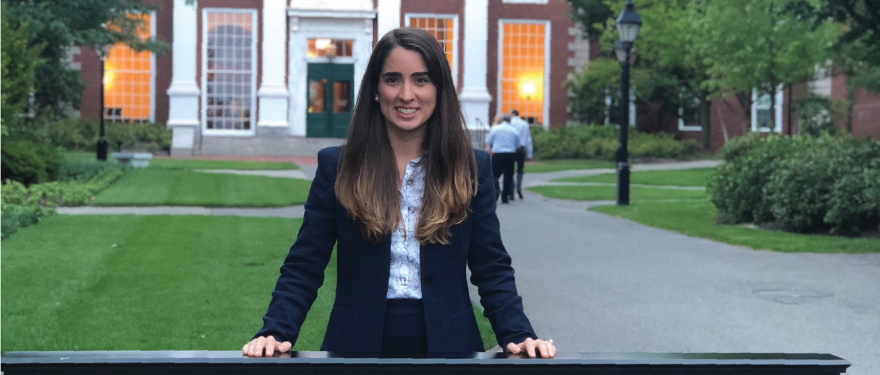After receiving my degree in Mechanical Engineering at Boston University, I lived in Austin, Texas for 2 years while working at Amazon. I held a role as an engineering project manager launching new transportation warehouses. As an engineering undergrad, I felt the
MBA would complement my technical skills with big-picture business vision. I chose Harvard’s MS/MBA: Engineering Sciences Program to become a strong leader while also refining the skills I would need to succeed in deeply technical fields.
I arrived in Boston on an unusually-hot Monday morning and was rushing to get settled in since I only had one week before classes started. On August 6th, I entered Pierce Hall on the Harvard John A. Paulson School of Engineering and Applied Sciences (SEAS) campus to start the program. It’s been just over a month since my first day, but I feel like I’ve grown so much already.
So, what did I learn this past month?
Regarding my classmates:
1. There’s a variety of STEM backgrounds
I came in expecting everyone to be a software engineer, but fortunately, I was wrong. There’s a mix of different types of engineers, as well as people with backgrounds in computer science, operations research, and data science. We even have a political-science-major-turned-software-engineer who learned to code at Dev Bootcamp.
2. There’s a wide range of industry experience
I also expected everyone to come from a big tech company. While there’s representation from some giants (Amazon, Microsoft, Apple), there are also cohort members that come from startups (sometimes their own) or government agencies.
3. The cohort is super impressive
Everyone is extremely smart. I was shocked with my
classmates’ sheer ability to absorb massive amounts of highly technical content in such a short period of time, but it wasn’t just that. On a daily basis, I would hear from classmates about their past experience in/plans of going into tough industries to tackle some of the most technically-challenging issues. Truly inspirational conversations.
Regarding the class content:
4. Statistics
This was a bit of a surprise for a class called “systems engineering.” We started with the basics and moved into more complex concepts and their real-world applications. For our midterm project, a classmate and I analyzed different parameters and the influence they had on Airbnb guest ratings using data from Boston listings. It was exciting to see how to apply what we learned in a real-life context. Many of my classmates felt they actually understood statistics for the first time thanks to the incredible faculty.
5. Systems and Controls
A little more expected for, again, a class called “systems engineering.” This part of the course focused on understanding the relationships between parts of a system and developing formulas to represent them: differential equations, Laplace transforms, and lots of diagrams. The content of this part of the course was a little closer to a traditional perception of engineering.
6. Business Modeling
The last part of the course revolved around modeling and analyzing a company using the tools covered in prior classes. We learned how to apply an engineering approach to representing business models and interpreting results. My group of 3 analyzed Blue Apron, the meal kit delivery company, to identify the parameters responsible for the valuation decrease and propose solutions. Sometimes it can be hard to make the connection between classroom and workspace, but this project definitely felt like something I would actually do at my job.
Regarding the class format:
7. “Intensive” is an understatement
On the first day, one of
our professors explained the
class format in numbers, a metric STEM people would understand: 13 weeks of content in 13 days. Given the short duration of the class, there was a lot of material covered every day and very (very very) little downtime. In a matter of 13 classes, we covered 3 content units, completed problem sets almost daily, had a mid-term statistical-analysis project, had a final modeling project, conducted two presentations, and had a final exam. Despite the accelerated format, it was still a full graduate-level class.
8. Being a small group has its advantages
Our first case was about Analytical Space Inc., a startup about space telecommunications founded by HBS alumni. During Orientation day, we went to visit the incubator where the startup operates. We had the privilege to meet the founders, ask them questions, and make our recommendations based on the case analysis. What an incredible experience!
Regarding everything else:
9. It’s nice to arrive on-campus before everyone else
From the logistics of moving in when there’s no traffic to the subtle advantage of identifying the best coffee spots, arriving early was a win. It gave me the time to acclimate to the Boston (and Cambridge) area. By the time all the other students were on campus for the first day of MBA classes, I already knew my way around.
10. The MS/MBA cohort became my family
It’s unreal to me how quickly we became so close. Maybe because of the intense class format that forced us to spend a lot of time together, maybe because we have similar interests in technology, maybe because we feel like we understand each other better than people from other fields. Whatever the reason, I’m so thankful it happened. In our cohort I found friendship, support, and ultimately, a new family.
Before coming to Boston, I struggled to decide if the MS/MBA: Engineering Sciences Program was right for me. I wondered if it’d be too much work or if it would affect my regular MBA experience. With those questions still in the back of my mind, I took the leap of faith. Since then, I found the answers to the things I wondered from a distance. Pursuing a joint degree impacts your regular MBA experience, but for the better, giving you another family on campus. It is a lot of work, but with incredible faculty support and amazing classmates, it is, or it has been for me at least, totally worth it.

